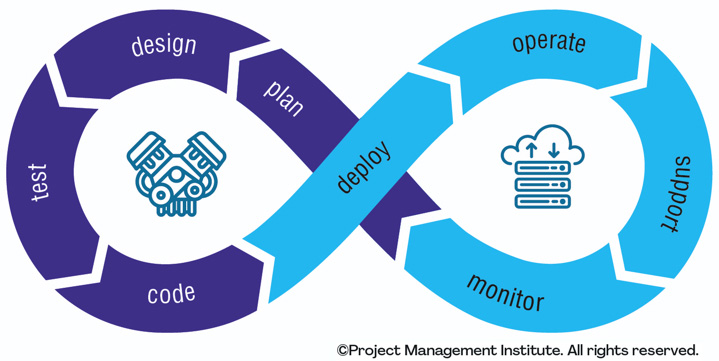As IT becomes an essential part of businesses, project and program managers have realized that the traditional waterfall methodology isn’t enough to handle the new demands of software development projects. To cope with the new realities of project management, new methods and frameworks have appeared to improve processes.
DevOps, Agile, and Scrum are three different approaches to managing projects that have had success in recent years. Each has its own set of pros and cons but understanding their differences is still a challenge for many business leaders given how they sometimes overlap.
In this post, we will explore the differences between these three strategies, and explain what they entail for your business.
Let’s start by defining each methodology and framework so we can start spotting the differences.
DevOps Defined
According to the Project Management Institute, DevOps is the streamlining of both operations and IT solution development. It also supports enterprise IT activities such as security and data management to provide more effective outcomes to both projects and organizations.
One of the caveats of DevOps is that it’s been defined in many ways. On the one hand, it’s a set of practices that automate and integrate processes so teams can build, test, and deploy software faster and reliably. On the other, it’s a combination of culture and tools that enable companies to build better software.
DevOps is at the crossroads between development and operations and aims to break the historical communication silos between both teams. A good way of visualizing the DevOps workflow is by depicting it as an infinite loop. In this loop, each different phase of the process relates to the other and flows sequentially to signal constant communication and collaboration through iterative approaches.

The Principles of DevOps
DevOps is built around the CAMS model (Culture, Automation, Measurement, and Sharing)
- Culture refers to communicating and collaborating as well as equally sharing responsibility for a project.
- Automation refers to the automation of processes such as development, testing, configuration, and deployment.
- Measurement is collecting data to power your decisions with factual information and keeping track of your progress and KPIs.
- Sharing creates collective intelligence and highlights the importance of collaboration for the DevOps lifecycle.
Agile Methodology Defined
According to the Agile Alliance, agile software development is an umbrella term for a set of frameworks and practices based on the Agile Manifesto for Software Development. Agile is a people-focused framework that emphasizes collaboration between self-organizing, cross-functional teams.
The agile method has revolutionized IT practices since the 1990s. Over the past thirty years, agile methodologies have increased success rates in software development while also improving quality and speed to market.
Agile development focuses on gaining more understanding of what’s going on in the environment we live in, the uncertainties and constraints your business faces, and how you can adapt to all of these factors as you go along.
The Principles of Agile Methodologies
- Individuals and interactions over processes and tools
- Working software over comprehensive documentation
- Customer collaboration over contract negotiation
- Responding to change over following a plan
Scrum Defined
Scrum.org defines the Scrum approach as a mindset for developing, delivering, and maintaining software products. More than a project management methodology, Scrum is a framework. Since it’s a non-prescriptive framework, Scrum allows project managers and teams to use any methodology they know.
Scrum fosters self-organization and embraces a heuristic approach that allows for uncertainty and unpredictability when solving problems. Scrum works well for distributed and remote teams because it emphasizes close collaboration but doesn’t require co-location to work.
A Scrum team is often small and consists of a project manager, a product owner, and the developers, all working in a horizontal environment where every team member is accountable for the project’s well-being.
The Principles of Scrum
- Control and transparency over the process
- Self-organization and independence
- Collaboration and adequate distribution of the tasks
- Value-based prioritization of tasks and deliverables
- Allocating and scheduling time for certain activities
- Iterative development and revisitation of the tasks
Comparing Scrum vs Agile vs DevOps
| Scrum |
Agile |
DevOps |
|
|
Uncertain Handling |
Problems can’t be fully defined up front, teams have to be quick to adapt to changes. |
Teams accept that they can’t know everything about a project before it starts. |
Uncertainties like resource availability and workload fluctuations need to be defined beforehand. |
| Favorable Conditions for Adoption |
Teams with high levels of trust, coordination, and collaboration. |
Teams with creative approaches to problem-solving and with less-structured processes. |
Teams that have automated or think of automating deployment and testing environments. |
| Work Rules |
Fixed sprints with consistent duration |
6-step process and fixed sprints |
Continuous integration and continuous delivery |
| Approach to Change |
Sprints are locked and change can be integrated at later sprints, not during them. |
Adopt new practices even if they differ from those of the organization. |
Accept change and integrate new practices to get to customers quickly. |
| Advantages |
|
|
|
| Challenges |
|
|
|
Agile DevOps: Merging Agile, Scrum, and DevOps
While there are specific friction points between these three practices, there are also many potential advantages to using them in your daily practice to increase user satisfaction and enable effective collaboration within a team.
Here are some ways in which Agile development can enhance a DevOps team and vice versa:
Improved Understanding of Tasks
Agile methodologies emphasize understanding each team member’s tasks. Mutual understanding enhances accountability and enables developers to transfer functions from one to another.
Greater Team Transparency
DevOps involves development and operations teams working together. Every member needs to understand the loop and needs to be able to collaborate with members of different teams.
DevOps Practices Can Enhance Sprints
Scrum teams can integrate DevOps practices while handling sprints by involving the DevOps team and the QA team in planning, meetings, and retrospectives.
Workflow Automation
Automation is part of the DevOps process and can be included in Agile and Scrum teams as part of the workflow and project planning. Emerging practices that leverage AI can be implemented to automate manual workflows too.
Better KPI Measurement
Merging the Scrum methodology or Agile practices into DevOps enhances the DevOps process by giving it better visibility over project metrics and KPIs.
All in all, there should be no DevOps vs Agile vs Scrum. Seeing each methodology and framework as contradicting practices is not only myopic but also dangerous to your company. The truth is that the three practices aren’t mutually exclusive, and companies using one approach can use the other. In fact, when used together, they can improve software development practices and lead to better products.

 Mike Vertal
Mike Vertal




